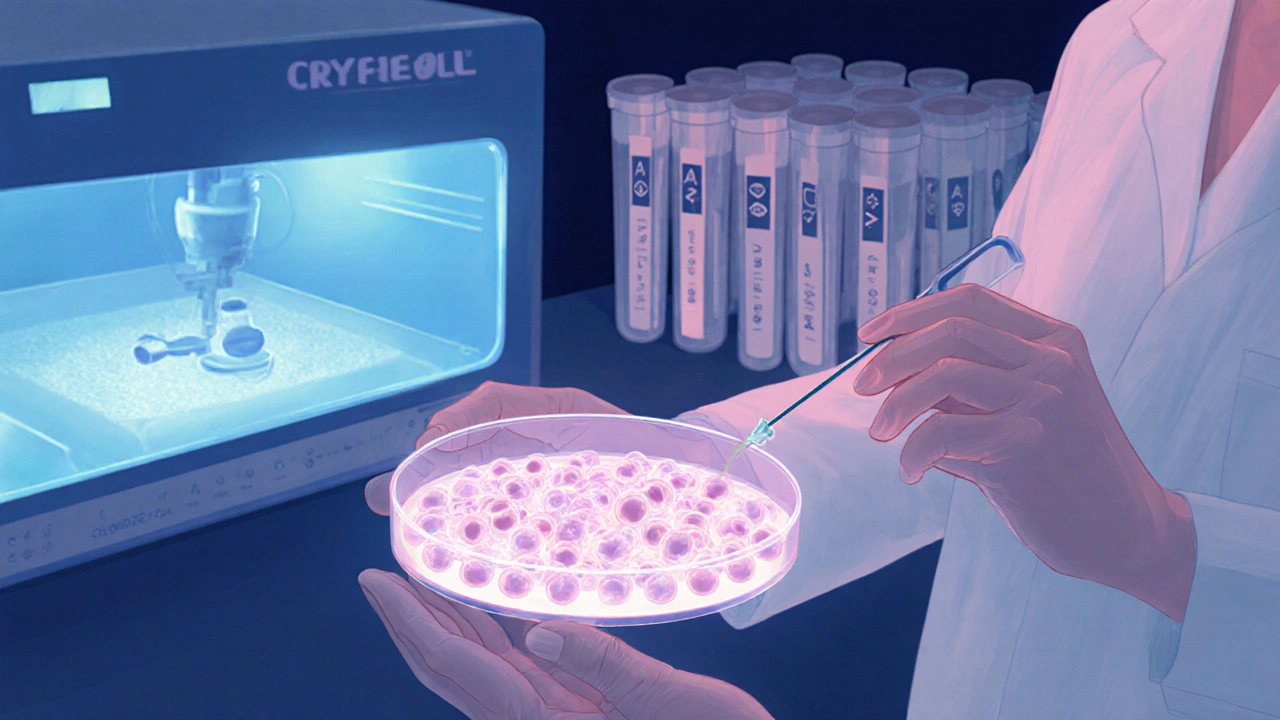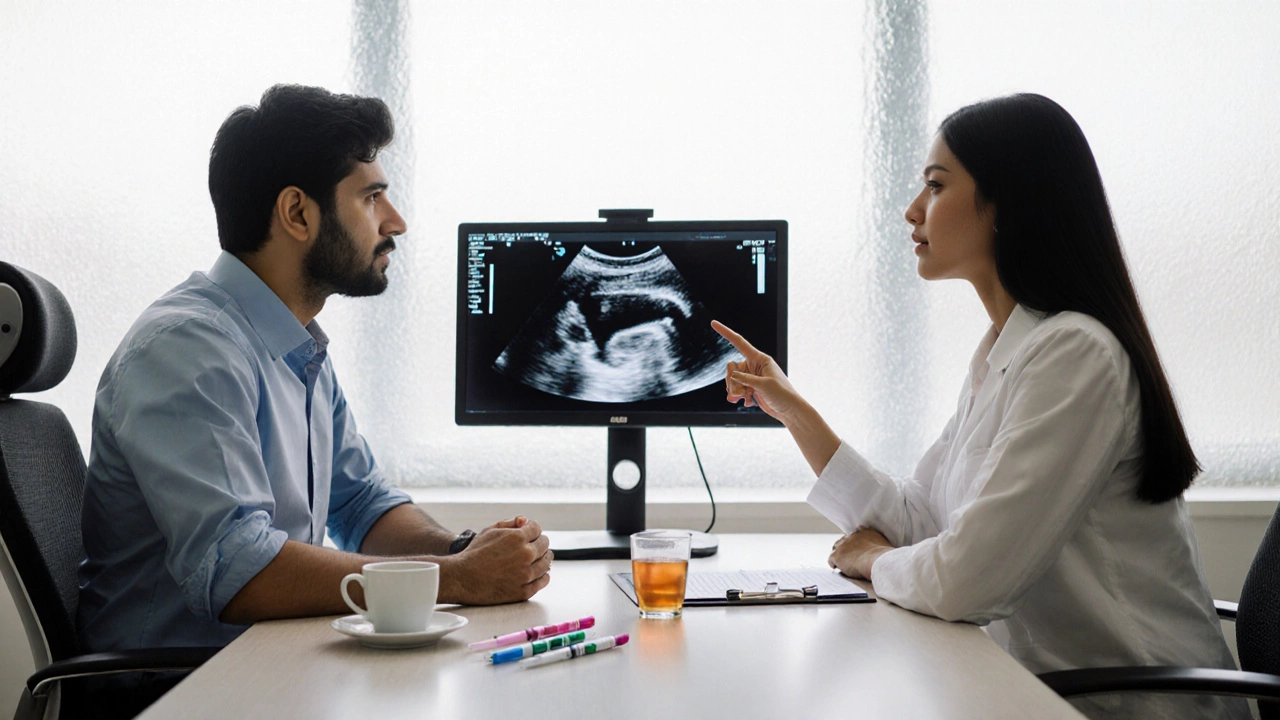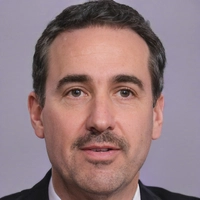IVF Success Calculator
Your IVF Success Estimate
Based on SART 2023 data and cumulative success rates by age group
Select your age group to see your estimated success rates
Key Takeaways
- Average live‑birth rate per fresh IVF cycle drops from around 45% for women under 35 to under 10% after age 42.
- Most couples achieve pregnancy within 2-4 cycles, but success is highly personal.
- Age, cause of infertility, embryo quality and clinic expertise are the biggest drivers of how many cycles you’ll need.
- Tracking cumulative live‑birth rates (including frozen‑embryo transfers) gives a clearer picture than looking at a single cycle.
- Lifestyle tweaks, pre‑implantation genetic testing and elective single‑embryo transfer can boost your odds without adding more cycles.
What an IVF Cycle Actually Is
In vitro fertilization (IVF) is a controlled ovarian stimulation, egg retrieval, fertilization in the lab, and embryo transfer process designed to help people conceive when natural conception is unlikely. It is the most common assisted reproductive technology worldwide and forms the backbone of modern fertility treatment. A single "round" or "cycle" usually includes hormone injections, monitoring, egg collection, fertilization (often with ICSI), embryo culture, and one or more transfers. Some clinics count a frozen‑embryo transfer as a separate cycle; others treat it as part of the original stimulation. Understanding how clinics define a cycle matters when you compare success statistics.
How Success Rates Are Reported
Success can be measured in several ways:
- Live‑birth rate per fresh transfer: the chance a woman will deliver a living baby after a fresh embryo is placed.
- Cumulative live‑birth rate: adds the outcomes of all subsequent frozen‑embryo transfers (FET) that stem from one stimulation.
- Clinical pregnancy rate: detection of a gestational sac on ultrasound, which is higher than live‑birth rates because some pregnancies end early.
Most patients focus on the cumulative figure because it reflects the total odds from one round of stimulation. The Society for Assisted Reproductive Technology (SART) and the European Society of Human Reproduction and Embryology (ESHRE) publish age‑stratified data that are widely used for counseling.

Average Numbers: How Many IVF Cycles Do People Usually Need?
The short answer is: it varies, but the data point to a clear pattern.
| Age Group | Fresh‑cycle live‑birth rate | Cumulative live‑birth rate (incl. FET) |
|---|---|---|
| Under 35 | 45% | 60% |
| 35‑37 | 33% | 48% |
| 38‑40 | 22% | 35% |
| 41‑42 | 12% | 20% |
| 43‑44 | 5% | 9% |
When you translate these percentages into expected cycles, a simple rule of thumb emerges:
- Women under 35 often achieve a live birth by the 2nd or 3rd IVF cycles (including any frozen‑embryo transfers).
- Couples in the 35‑38 range typically need 3‑4 cycles to reach a similar cumulative chance.
- After age 40, the odds decline sharply; many need 4‑6 cycles-or consider donor gametes-to approach a 20‑30% cumulative success.
These averages hide personal nuances, but they give a realistic baseline for planning.
Key Factors That Influence How Many Cycles You’ll Need
Two broad categories drive the number of attempts required: patient‑related factors and clinic‑related factors.
Patient‑Related Factors
- Maternal age: Egg quality declines sharply after 35, making each egg less likely to develop into a viable embryo.
- Cause of infertility: Conditions like severe male factor, tubal blockage, or uterine abnormalities often need extra interventions (ICSI, surgical correction) that can lower success per cycle.
- Ovarian reserve: Low AMH or antral follicle count predicts fewer eggs retrieved, reducing the pool of embryos.
- Previous IVF outcomes: A failed fresh transfer but good-quality frozen embryos can improve cumulative rates without more stimulation.
- Lifestyle: Smoking, high BMI, and excessive caffeine have measurable negative impacts on implantation.
Clinic‑Related Factors
- Lab quality: Success rates differ by a few points between high‑volume labs with strict quality control and smaller centers.
- Embryology techniques: Use of blastocyst culture, time‑lapse imaging, and pre‑implantation genetic testing (PGT) can increase the chance of a transferable embryo.
- Elective single‑embryo transfer (eSET): While eSET reduces multiple‑birth risk, it can modestly lower per‑transfer live‑birth rates and may require an extra cycle.
- Patient support: Clinics that provide counseling and personalized dosing often achieve better adherence, translating into higher success.
Strategies to Boost Your Odds Without Adding More Rounds
If you’re staring at the prospect of a fourth or fifth cycle, consider these evidence‑backed tweaks.
- Pre‑implantation genetic testing (PGT‑A): Detects aneuploid embryos before transfer, raising live‑birth rates per transfer especially for women over 38.
- Freeze‑all strategy: Allows embryos to be transferred in a later, hormonally natural cycle, which can improve implantation for some patients.
- Optimized stimulation protocols: Minimal‑stimulation (Mild IVF) can yield better egg quality in older patients, while high‑dose protocols help those with low ovarian reserve.
- Lifestyle optimization: Reducing BMI to 18‑25, quitting smoking, and managing stress have been shown to lift success rates by 5‑10%.
- Adjunct treatments: Low‑dose aspirin, vitamin D correction, and growth hormone in select cases have modest benefits.
When to Re‑Evaluate - Deciding If You Should Continue or Pause
There’s no universal “stop‑at‑three‑cycles” rule, but many clinics counsel patients after the third failed attempt, especially if the cumulative live‑birth rate is below 20% and no modifiable factors remain.
Ask yourself these questions after each round:
- Did the clinic produce high‑quality embryos (grade≥B) that were transferred or frozen?
- Are there any medical reasons (e.g., untreated uterine pathology) that could be corrected?
- Have you optimized lifestyle and any adjunct therapies?
- Does your emotional and financial bandwidth support another cycle?
If the answer to most of these is "yes," continuing may be reasonable. If several are "no," it’s time to discuss alternatives such as donor eggs, surrogacy, or adoption.
Frequently Asked Questions
How many IVF cycles on average lead to a live birth?
For women under 35, the cumulative live‑birth rate after up to three cycles (including all frozen transfers) reaches about 60%. For the 35‑38 age group, three to four cycles typically give a 45‑50% chance. After 40, most couples need four or more cycles, and success plateaus around 20‑30%.
Does using donor eggs reduce the number of cycles needed?
Yes. Donor eggs from young, healthy donors have a fresh‑cycle live‑birth rate of 55‑60% regardless of the recipient’s age, meaning many achieve pregnancy within the first or second cycle.
Should I opt for fresh or frozen embryo transfer?
Studies show similar or slightly higher live‑birth rates with frozen transfers when the endometrium is prepared in a natural or hormone‑replaced cycle. If you have a high estrogen environment after stimulation, a freeze‑all approach may improve implantation.
What is the typical emotional timeline across multiple cycles?
Emotions often swing from optimism to disappointment after each cycle. Counseling, support groups, and mindfulness techniques can help maintain mental health. Many clinics now embed a mental‑health professional in the IVF team to monitor stress levels.
When should I stop trying IVF and consider other options?
If after three to four full cycles the cumulative live‑birth probability stays below 15% and no correctable medical issues exist, most specialists recommend discussing donor gametes, surrogacy, or adoption as alternatives.






